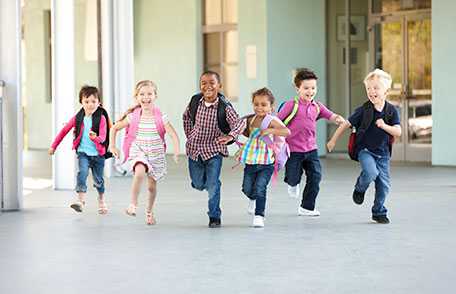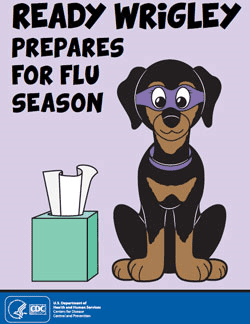Schools and Childcare – Preparing for the Unexpected

In the United States, about 69 million children are separated from their parents or caregivers every workday to attend school or childcare. Because an emergency can happen anywhere and at any time, it is important that schools and childcare providers prepare to protect the children in their care.
Public health emergencies and disasters affect millions of children worldwide each year. These emergencies and disasters include natural events (such as severe weather, earthquakes, fires, floods, and tsunamis) and man-made events (such as acts of terrorism). Since the next natural or man-made disaster is inevitable, it is critical that children are protected during and after any event.
Emergencies and disasters often affect children differently than adults. Children’s unique needs and body differences put them at greater risk during a disaster. Educators and childcare providers can help children stay safe in emergencies by becoming familiar with the physical, developmental and emotional characteristics that make children vulnerable in an emergency or disaster.

The Ready Wrigley children’s activity books help teach children the importance of preparedness.
Children – Your Partner in Preparedness
Disasters and emergencies are scary and confusing for children, especially younger children. Actively involving children in their own preparedness is a great way to give them a sense of control during a time that may be chaotic. Childcare providers and elementary educators can teach children the following basics of staying safe in emergencies by using age-appropriate activities that are fun, empowering, and inclusive:
- Make an example classroom disaster kit as a class project. Talk as a class about what to include and why.
- Practice evacuating from a building, such as fire drills, help children know what to do and where to go during an emergency.
- Use Ready Wrigley activity books. Ready Wrigley books can help children between ages 2 and 8 years understand what might happen in different types of disasters and what they can do to stay safe. These books have fun activities that teach children about preparedness practices that they can apply at school and at home.
- Help young children fill out Ready Wrigley’s backpack card [487 KB] with emergency contact information. Work with older children to make sure they know who to contact and where to go in case of an emergency during the school day.
Plan. Practice. Repeat.
Since school and childcare centers are an integral part of any community, it is important that they develop disaster plans in partnership with local community groups, such as law enforcement, fire safety, emergency medical services, public health, pediatricians, faith-based organizations, and other community leaders. Practicing disaster plans regularly helps everyone feel natural in their response roles.
There is no one ideal emergency plan. Individual school or childcare center emergency plans vary, depending on the resources available in the community. The following recommendation for school and childcare center preparedness plans include these key components:
- Connecting with state and local emergency responders, local government, and community partners to develop a school Emergency Operations Plan.[1.77 MB]
- Conducting emergency drills that include both staff and children so that everybody knows their roles and responsibilities during an emergency or disaster.
Helping Children Cope
An important role for childcare providers and educators is helping children cope during and after an emergency or disaster. Age, demographics, emotional well-being, social networks, and previous experience with traumatic events all affect a child’s reaction to danger or a threat. Because their communication skills are still developing, they may not be able to tell you how they feel. For this reason, it is important to pay attention to other forms of expression, such as being fussy or irritable, problems sleeping, and changes in behavior or appetite.
Children’s abilities to cope with stressful situations improve when they know what is happening. Childcare providers and educators can do the following to help children cope:
- Let children speak about their fears. Use age-appropriate language to help correct information that is not true. This will help children adjust to the situation and improve their sense of safety.
- Provide children with support to continue to share their concerns and fears in the days or weeks following an event. Consult with a mental health professional for help if the children need additional support.
- Learn more about psychological first aid, trauma-informed care, and how to meet children’s emotional needs during and after an emergency or disaster.
Disasters happen, but how we prepare for them can make a difference. The more schools and childcare centers plan and practice, the better they can protect children in their care when an emergency or disaster arises.
More Information
- Caring for Children in a Disaster: website with information about protecting children in emergency situations (Centers for Disease Control and Prevention)
- Helping Children with Disabilities Cope with a Disaster or Traumatic Event: tips for parents and educators to reduce stress from a traumatic event (Centers for Disease Control and Prevention)
- National Education Association’s School Crisis Guide: includes resources for preparing for, reacting to, and responding to a crisis (National Education Association)
- Multihazard Planning for Childcare: free, interactive, web-based training from the Federal Emergency Management Agency (Federal Emergency Management Agency)
- Disaster Checklists: preparedness checklists for parents and child care professionals (Save the Children)
- Youth Emergency Preparedness Curriculum:curriculum developed for children that teachers can use (Federal Emergency Management Agency)
- Tips for Talking With and Helping Children and Youth Cope After a Disaster or Traumatic Event [1.24 MB] (Substance Abuse and Mental Health Services Administration)
- Page last reviewed: September 18, 2017
- Page last updated: September 18, 2017
- Content source:
- National Center on Birth Defects and Developmental Disabilities
- Page maintained by: Office of the Associate Director for Communication, Digital Media Branch, Division of Public Affairs




 ShareCompartir
ShareCompartir